Thinking in a foreign language makes us more rational
Friday, August 15, 2025
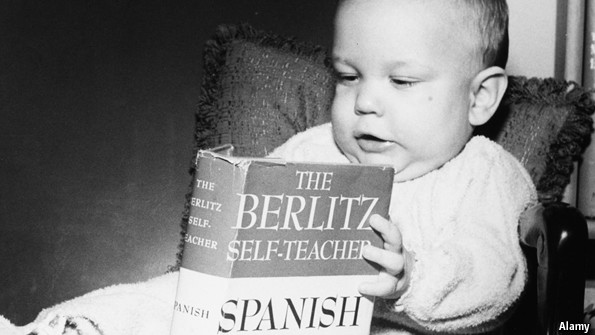 Ever heard this as a child? : “What language do you need me to use so you’ll pay attention?” Ever heard this as a child? : “What language do you need me to use so you’ll pay attention?”
It turns out that there is some truth behind the question. A series of recent scientific studies suggests that we think and make decisions differently if we process the information in a language other than our mother tongue.
Even if we grasp the notion equally well in both languages, our final decision on the matter will tend to be better thought out, less emotional and more results-oriented.
A leading expert on bilingualism at Pompeu Fabra University in Barcelona, Albert Costa, believes it is good for deliberative thinking; it makes you think twice about things.
Costa began his research with the tramway dilemma: would you push someone onto the tracks if that death were to save the lives of five other people? The moral conflict involved in sending someone to their death appears to vanish when the question is put to subjects in a language other than their mother tongue.
The proportion of people willing to sacrifice a person for the larger good shot up from 20% to nearly 50%, with the only difference being that they processed the question in a second language.
It appears that processing information in a foreign language makes us less prone to emotional thinking and more focused on efficient results. We become less moralistic and more utilitarian.
The research also finds that thinking in another language increases our tolerance for risk-taking on anything from planning a trip to embracing a new breakthrough in biotechnology.
As the Nobel winner Daniel Kahneman explains, our brain seems to have a System 1, which focuses on fast, instinctive and stereotypic thinking, and a System 2, which deals with issues requiring greater consideration.
In our native language, we may be more prone to using System 1, while the additional effort required for thinking in a foreign language might trigger System 2. This could explain the higher percentage of people who overcome loss aversion and moral dilemmas in a foreign language.
For instance, these insights might be useful during negotiations that require participants to put their personal feelings to one side and focus on the greater good.
 3
Like
Published at 4:40 PM Comments (0)
3
Like
Published at 4:40 PM Comments (0)
Aircon...before Aircon
Friday, June 13, 2025
Before air conditioning became a household standard, people had to come up with ingenious methods to beat the heat, especially in countries with hot climates like Spain. Spain's rich history and geographical diversity have given rise to various traditional practices to stay cool during the scorching summer months. Here, we explore some of the age-old Spanish tricks that made the summers more bearable before the luxury of air conditioning.
White-Washed Walls
One of the most visually striking and practical traditional methods to keep buildings cool is the whitewashing of exterior walls. This practice was particularly prevalent in the Andalusian region. The white lime paint reflects the sun's rays, significantly reducing heat absorption by the buildings and keeping the interiors cooler. Towns like Ronda and the famous Pueblos Blancos are testament to this effective technique, showcasing picturesque villages that gleam under the sun while providing respite from the heat to their inhabitants.
Thick Walls and Small Windows
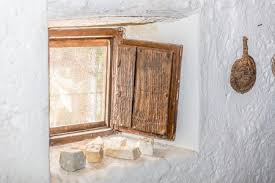
Traditional Spanish architecture features homes with thick walls made of adobe or stone and smaller windows than what modern design might dictate. These elements are crucial in insulating the house from the outside heat. The mass of the walls absorbs the heat during the day and releases it slowly during the cooler nights, maintaining a more constant temperature inside the homes. Smaller windows minimized the amount of direct sunlight entering the rooms, further helping to keep interiors cool.
Interior Patios and Courtyards
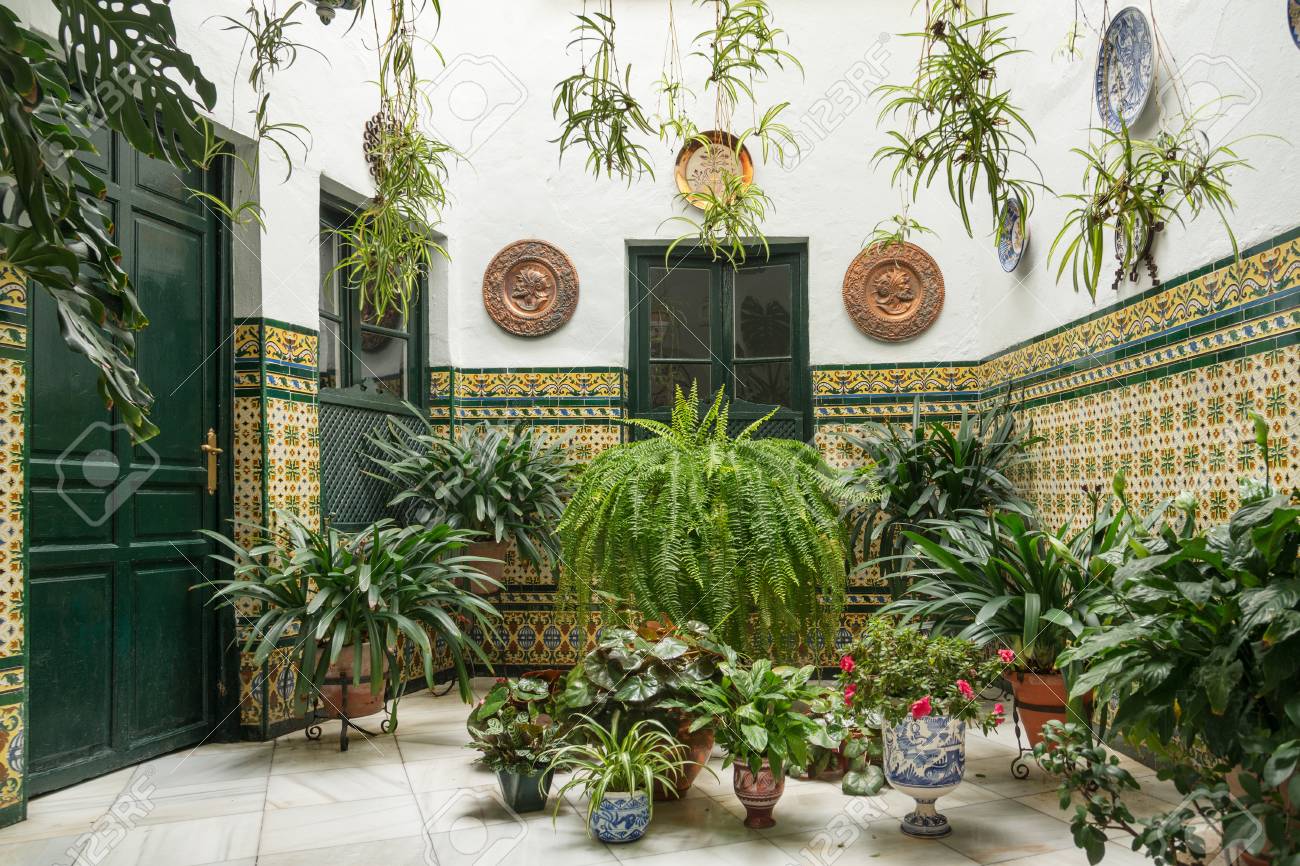
Many traditional Spanish houses feature an internal patio or courtyard, often with a fountain at its center. This design is not just for aesthetics; it serves a practical purpose in cooling. The courtyards offer shaded outdoor spaces protected from the direct sun, while the water from fountains adds humidity, helping cool the air through evaporation. Plants and trees in these spaces also contribute to a cooler microclimate, offering a pleasant refuge from the summer heat.
Cross Ventilation
Cross ventilation takes advantage of the natural breezes to cool homes. This strategy involves opening windows or doors on opposite sides of a house to allow air to flow through. In traditional Spanish homes, particularly those with inner courtyards, cross ventilation helps circulate air, pushing hot air out and letting cooler air in. This method is most effective during the evening and early morning hours when the outside air is cooler than the inside air.
Night-time Air Flow
Taking advantage of the cooler night air is another strategy employed in traditional Spanish homes. Residents would close their homes during the hot daytime hours to keep the heat out and open them up at night to allow the cool air to circulate through the interiors. Often, families would sleep on rooftops terraces or balconies to escape the day's accumulated heat within the home's walls.
Natural Fabric and Clothing
The traditional Spanish attire, such as the light and airy "flamenco" dresses or the loose, comfortable "camisa de manta," reflects an intrinsic understanding of how to stay cool. These clothes are usually made from natural fibers like cotton or linen, which are breathable and promote the evaporation of sweat, thus cooling the body more efficiently than synthetic fabrics.
Strategic Planting
The strategic planting of trees and vines around homes was another method used to create shade and protect buildings from direct sunlight exposure. Deciduous trees, which lose their leaves in the winter, were particularly valued as they provide shade during the summer while allowing sunlight to penetrate and warm the house during the colder months.
In the absence of modern cooling technologies, these traditional Spanish methods provided effective solutions to the problems posed by the summer heat. Today, with a growing interest in sustainable living practices, these time-tested strategies are gaining renewed attention. They remind us of the ingenuity of past generations and offer inspiration for ecologically responsible design in our quest to stay cool in the heat
 3
Like
Published at 11:49 PM Comments (0)
3
Like
Published at 11:49 PM Comments (0)
Which Spanish town gets the most rain?
Thursday, May 15, 2025
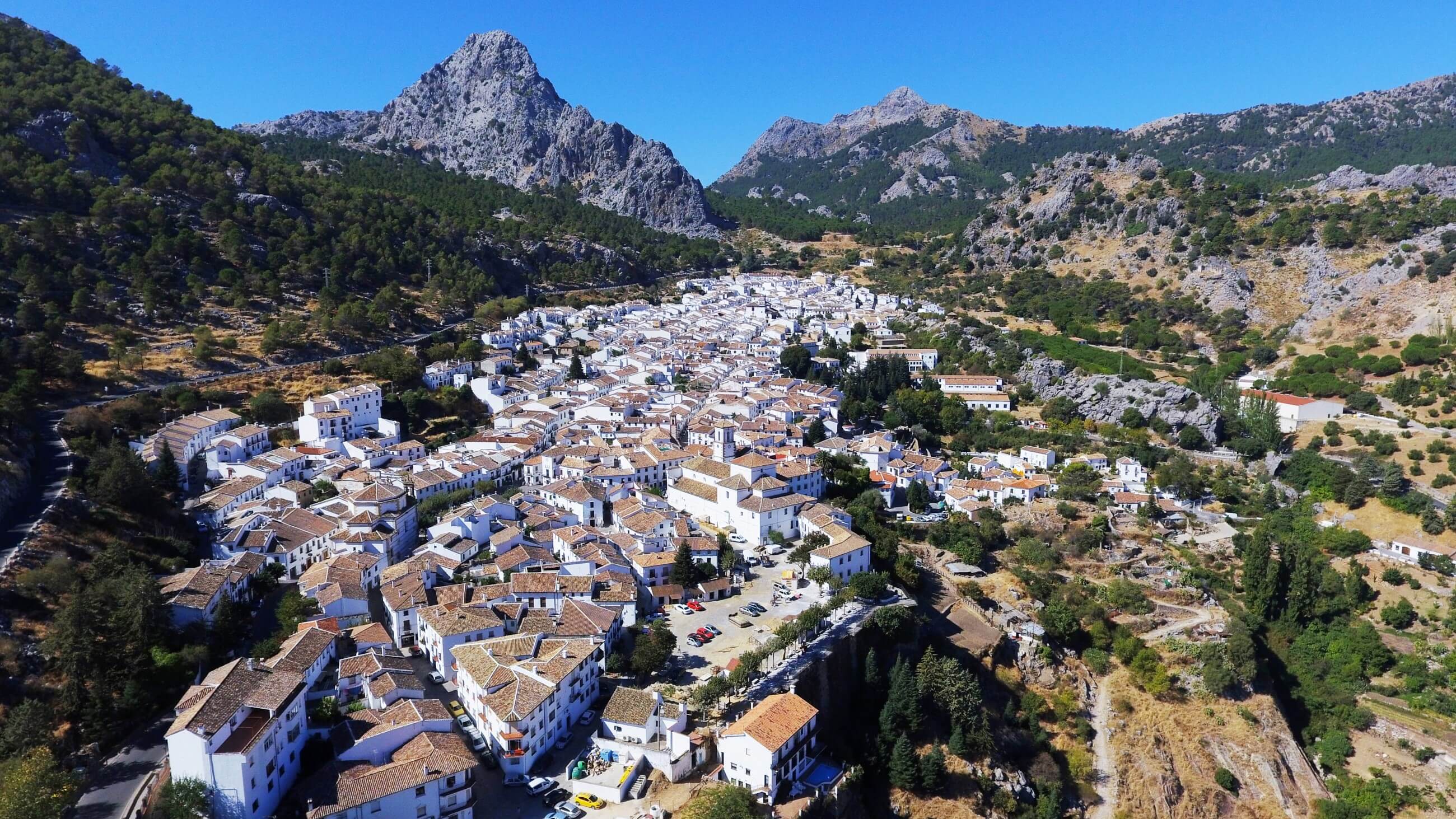
Would you live in a town that rains every other day? If you are one of those people who love the rain, this town may be perfect for you. This Spanish town in the province of Cádiz is located in the northeast of the province, in the reserve area of the Sierra de Grazalema Natural Park.
The name of the town is Grazalema and its rainfall rate is the highest in Spain, registering more than 1,962 mm of average annual rainfall in the municipality. To put that into perspective London has an annual rainfall of around 592mm! And the average for the whole of the UK is 885mm per year. So more than double the UK average. In addition, it is unsurprisingly the home to the source of the Guadalete River.
It is the first mountainous area to encounter the humid Atlantic winds which enter from the southwestern coast, causing the town of Cádiz to have high rainfall. As the water passes through the low and warm lands, this air cools as it increases in altitude, causing the clouds that will later drop the rain.
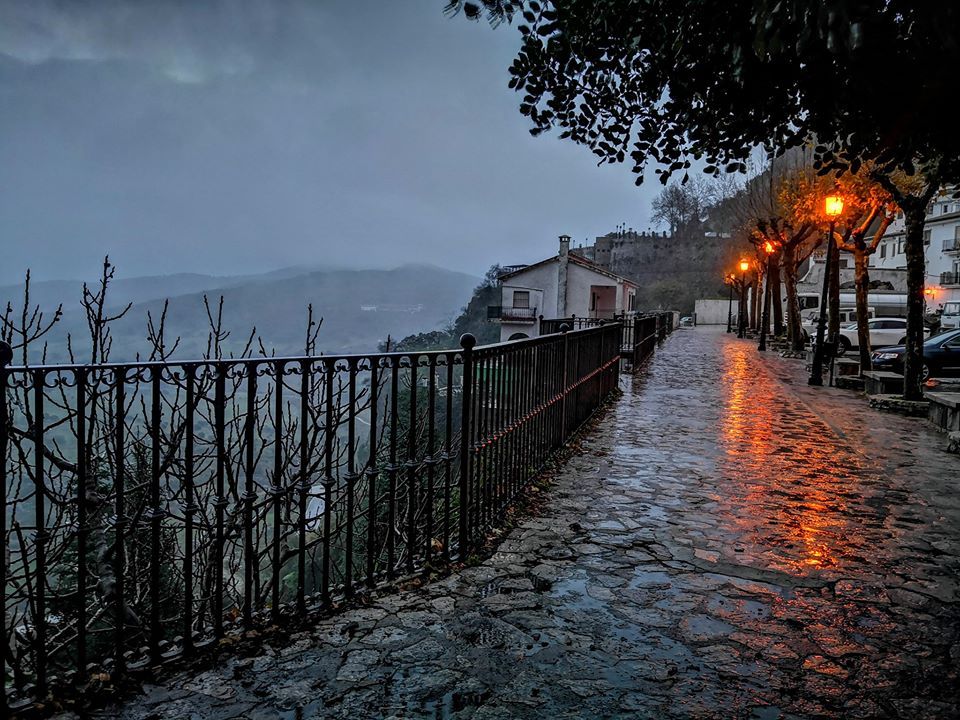

Grazalema has a considerable variation of monthly rainfall according to the season. The rainy period of the year lasts for 8.5 months, from September 10 to May 28, with a sliding 31-day rainfall of at least 0.5 inches.
Within the municipality, we encounter a Cadiz village with its urban centre that was declared a Historic Site, where you can see various buildings built according to the typical popular architecture.
It also boasts several churches that must not be missed. The first of them, and the most important, is the 18th century Baroque Church of Nuestra Señora de la Aurora, accompanied by the Church of the Incarnation, from the 17th century but renovated in the 19th. We can also find the Church of San Juan, from the 18th century, followed by the Church of San José, from the 17th century. Without forgetting its only hermitage from the 20th century, under the invocation of Our Lady of the Angels.
Benamahoma is the name of the district which the arabas called 'Ben-Muhammad', meaning "sons of Muhammad." In this municipality, the Islamic influence can be seen in the peculiar layout of its streets. You can also go through the Museum of Textile Crafts where you can see artisan objects such as numerous collections of blankets. The town is famous for its traditional handmade blankets.
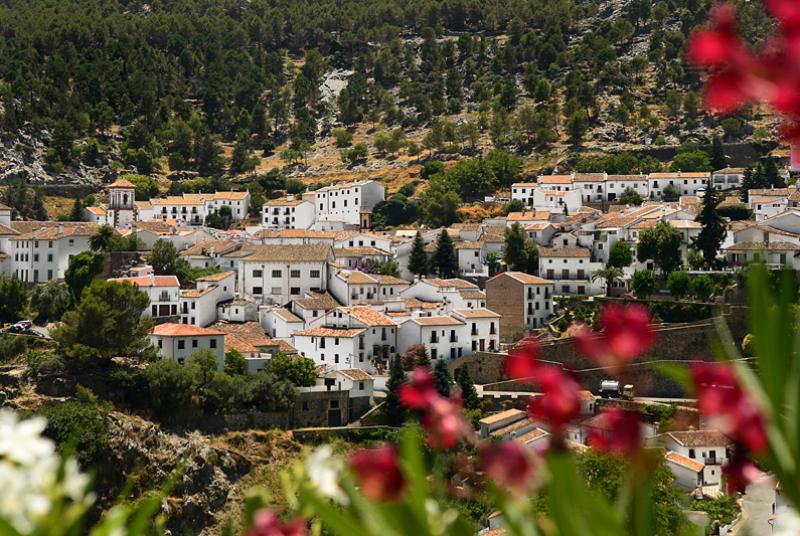
Without forgetting the fabulous traditional Cadiz cuisine, in Grazalema, you can taste numerous typical dishes. A wonderful example would be the Grazalema soup, a stew broth made with egg, chorizo, bread and mint. Some of its other specialities are the 'tagarninas' or the very typical roast lamb.
 1
Like
Published at 7:17 PM Comments (0)
1
Like
Published at 7:17 PM Comments (0)
Casa das Pedriñas: A Stone-Studded Labour of Love in Rural Spain
Friday, May 2, 2025
Nestled in the picturesque countryside of Veiga, Spain, stands a peculiar and enchanting structure that has captivated the imaginations of locals and visitors alike for decades. The Casa das Pedriñas, or "House of Little Stones," is a testament to one man's unwavering dedication, creativity, and passion. This remarkable dwelling, adorned with thousands of small, polished stones, tells a story of perseverance, artistry, and the extraordinary lengths one person can go to realise their dreams.

The Visionary Behind the Stones
The tale of Casa das Pedriñas begins with Daniel Mancebo, a local miner affectionately known in his hometown as "El Bailarín" (The Dancer). In 1970, Mancebo embarked on an ambitious project that would consume nearly three decades of his life. His vision? To create a home unlike any other, one that would stand as a lasting tribute to his creativity and connection to the land he loved.
Mancebo's journey was not one of instant gratification or overnight success. Instead, it was a slow, methodical process that required immense patience, skill, and dedication. From 1970 until his passing in 1998, Daniel poured his heart and soul into this unique endeavour, transforming a simple house into a work of art that continues to captivate and inspire to this day.
A Labour of Love and Frugality
What makes the Casa das Pedriñas truly remarkable is not just its appearance, but the story of sacrifice and determination behind its creation. Daniel Mancebo was not a wealthy man, nor did he have access to vast resources. As a miner, he lived a modest life, but he harboured grand ambitions for his stone-covered dream home.
To fund his project, Mancebo adopted a frugal lifestyle, saving every peseta he could spare from his earnings. This financial discipline allowed him to slowly but surely accumulate the resources needed to bring his vision to life. It's a poignant reminder that great achievements often require personal sacrifice and unwavering commitment.
Nature's Palette: Sourcing the Stones
One of the most fascinating aspects of the Casa das Pedriñas is the origin of its decorative elements. Daniel didn't simply purchase stones from a quarry or a landscaping supply store. Instead, he embarked on regular expeditions into the nearby mountains, searching for the perfect specimens to adorn his home.
These excursions into nature served a dual purpose. Not only did they provide Mancebo with the raw materials for his project, but they also deepened his connection to the landscape around Veiga. Each stone collected represented a piece of the local geography, effectively bringing the essence of the mountains to his doorstep.
The Art of Transformation
Collecting the stones was only the first step in Mancebo's creative process. Once he had gathered enough raw materials, he set about transforming them into the polished gems that would eventually cover his home. Armed with nothing more than a mallet and his own two hands, Daniel meticulously worked each stone, coaxing out its hidden beauty.
This polishing process was time-consuming and labour-intensive, requiring both physical strength and a keen eye for detail. Mancebo would spend countless hours hunched over his workbench, carefully shaping and smoothing each stone until it met his exacting standards. The result of this painstaking work was a collection of stones that shimmer and gleam, catching the light in a way that brings the house to life.
A Symphony in Stone
As visitors approach the Casa das Pedriñas, they are immediately struck by its unique appearance. The entire exterior of the house is covered in a mosaic of small, polished stones, creating a textured, multi-coloured surface that seems to dance in the sunlight. The overall effect is both rustic and refined, a perfect blend of natural beauty and human artistry.
The stones vary in size, shape, and colour, reflecting the diverse geology of the surrounding area. Shades of grey, brown, and white dominate, punctuated by occasional flashes of quartz or other eye-catching minerals. This variety creates a dynamic visual experience, with the eye constantly discovering new patterns and combinations as it roams across the facade.
More Than Just a House
While the Casa das Pedrias is undoubtedly a residential structure, it transcends the typical definition of a home. In many ways, it serves as a three-dimensional canvas, showcasing Daniel Mancebo's artistic vision and his deep connection to the land. Each carefully placed stone tells a story - of long days spent in the mountains, of evenings dedicated to polishing and arranging, and of a dream slowly taking shape over the course of decades.
The house stands as a prime example of outsider art and vernacular architecture. These terms refer to creative works produced by individuals without formal training, often resulting in unique and deeply personal creations. The Casa das Pedrias embodies this spirit, representing one man's singular vision brought to life through sheer determination and creativity.
A Dream Unfinished
Tragically, Daniel Mancebo passed away in 1998 before he could fully realise his vision for the Casa das Pedriñas. Despite dedicating nearly 30 years to the project, there were still areas of the house that remained unadorned at the time of his death. This unfinished state adds a bittersweet note to the property's story, serving as a poignant reminder of the fragility of human life and the ambitious scale of Mancebo's dream.
 
The Challenge of Preservation
Today, the Casa das Pedriñas stands as a unique cultural landmark in Veiga, attracting curious visitors from near and far. However, the future of this extraordinary structure remains uncertain. The house is currently abandoned, facing the dual challenges of time and neglect.
The primary obstacle to preserving the Casa das Pedriñas is the high cost of maintenance. The intricate stone covering requires specialised care to prevent deterioration, and the house's unique construction presents challenges not typically encountered in standard building preservation. Mancebo's heirs, while undoubtedly proud of their ancestor's creation, find themselves unable to shoulder the financial burden of properly maintaining the property.
This situation raises important questions about the preservation of outsider art and unconventional architecture. How can society balance the need to protect these unique cultural assets with the practical realities of maintenance costs? Should local or national governments step in to safeguard such properties, or are there other innovative solutions that could ensure the Casa das Pedriñas continues to inspire future generations?
A Source of Local Pride
Despite its current state of abandonment, the Casa das Pedriñas remains a source of pride for the people of Veiga. It stands as a testament to the creativity and determination of one of their own, a tangible reminder that extraordinary things can emerge from even the most unassuming beginnings.
Local legends and stories have sprung up around the house and its creator. Some say that on quiet nights, you can still hear the tap-tap-tap of Daniel's mallet as he works on his beloved stones. Others claim that the house possesses mystical properties, with the stones whispering secrets to those who listen closely. While these tales may be more fiction than fact, they speak to the deep impression the Casa das Pedrias has made on the collective imagination of the community.
The Legacy of Daniel Mancebo
In creating the Casa das Pedrias, Daniel Mancebo left behind more than just a uniquely decorated house. He bequeathed to his community, and to the world, a powerful reminder of what can be achieved through passion, perseverance, and a willingness to pursue one's dreams, no matter how unconventional they may seem.
Mancebo's legacy serves as an inspiration to artists, dreamers, and non-conformists everywhere. It encourages us to look at the world around us with fresh eyes, to see the potential for beauty and creativity in the most ordinary of objects. The Casa das Pedriñas stands as a monument to the human spirit's capacity for imagination and the transformative power of dedicated, patient effort.
Looking to the Future
As we consider the future of the Casa das Pedriñas, it's clear that action is needed to preserve this unique piece of cultural heritage. Perhaps a solution lies in community involvement, with local residents coming together to maintain and promote the site. Or maybe a benefactor will step forward, recognising the value of this extraordinary creation and providing the resources needed for its upkeep.
Whatever the future holds, one thing is certain: the Casa das Pedriñas will continue to captivate and inspire all who encounter it. It stands as a testament to the power of dreams, the beauty of nature, and the incredible things that can be achieved when one person decides to turn their vision into reality, one small stone at a time.
In the end, the story of the Casa das Pedriñas is more than just an tale of unusual architecture or outsider art. It's a reminder of the extraordinary potential that lies within each of us, waiting to be unleashed. Daniel Mancebo's stone-covered house serves as a call to action, encouraging us all to pursue our passions, no matter how outlandish they may seem, and to leave our own unique mark on the world.
 0
Like
Published at 11:42 PM Comments (1)
0
Like
Published at 11:42 PM Comments (1)
Napoleon's Spain
Friday, April 25, 2025
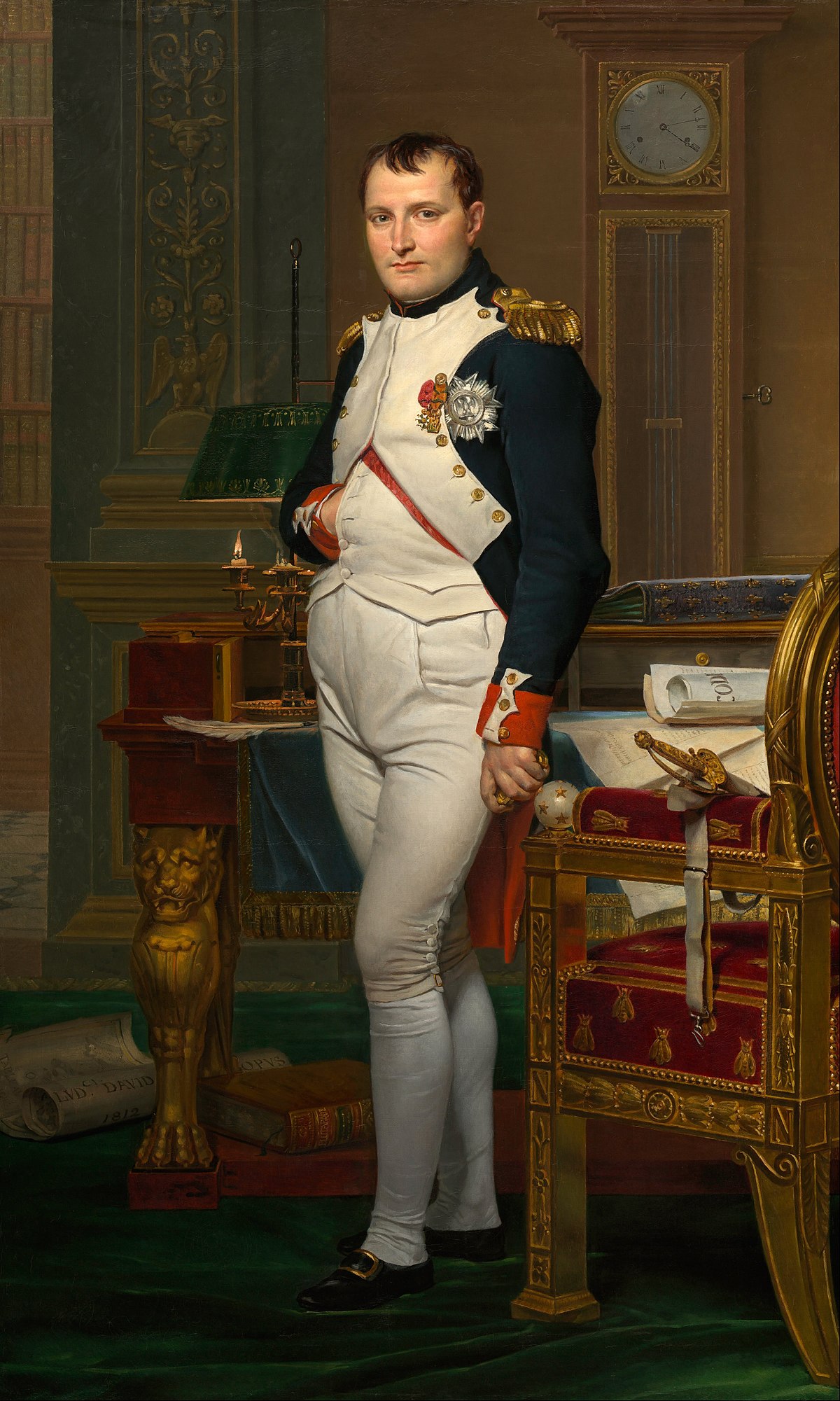 In the year 1810, José I, brother of Napoleon Bonaparte, the victorious French general who ended up proclaiming himself emperor until his defeat by the British and Prussians at Waterloo, reigned in Spain. In the year 1810, José I, brother of Napoleon Bonaparte, the victorious French general who ended up proclaiming himself emperor until his defeat by the British and Prussians at Waterloo, reigned in Spain.
Spain had suffered the French invasion, from which it would manage to free itself in 1814 at the end of the War of Independence and which, according to many analysts, was the beginning of the end for Napoleon.
During this French occupation, the Spanish government sponsored by Paris wanted to administratively reorganise the entire country, and among other changes, wanted to impose a division by provinces very different from the current one.
The design was carried out by José María de Lanz and Zaldívar, who was inspired by the administrative division of France. The idea was to take advantage of natural features and try to make each province approximately the same size.
Lanz did away with historical names and wanted each province to be named after the dominant river or rivers. Thus, there were Ebro and Jalón, Guadalquivir Bajo, Duero and Pisuerga, Segura or Miño Alto.
In addition, new, not necessarily traditional, capitals were established: towns such as Astorga, La Carolina, Ciudad Rodrigo or Jerez became provincial capitals.
Napoleon's Map of Spain
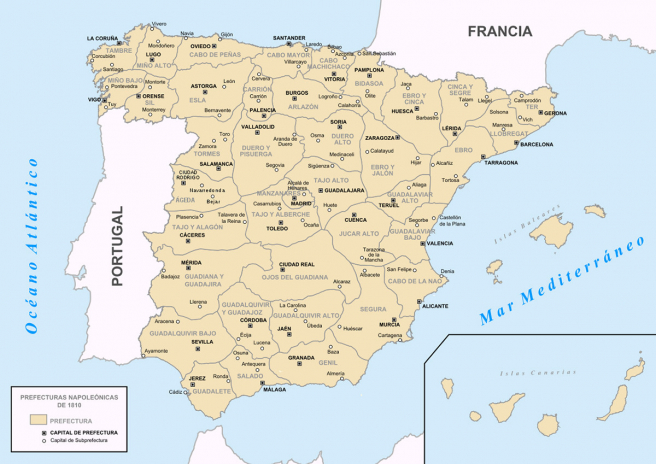
The problem is that this method ignored historical realities and decisions were made such as dividing Zaragoza into two provinces. Finally, the end of the French occupation put an end to this scheme and in 1833 one very similar to the current one would be adopted.
VIDEO IN ENGLISH
 0
Like
Published at 10:20 PM Comments (0)
0
Like
Published at 10:20 PM Comments (0)
Museum of Torture in Toledo
Friday, April 18, 2025
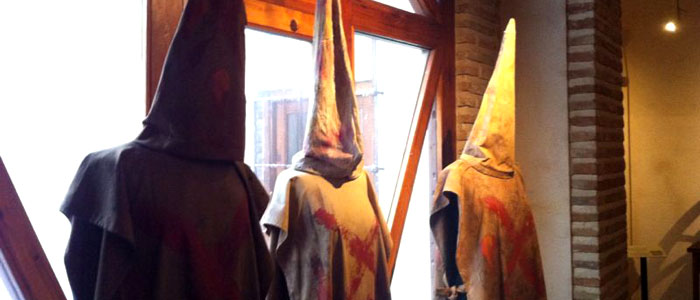
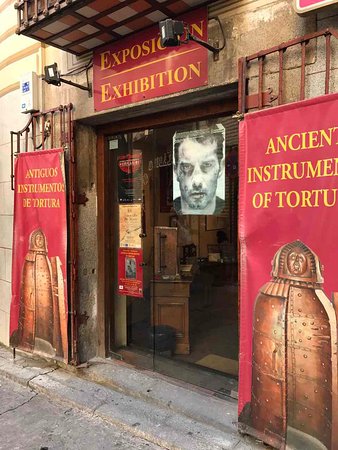 Toledo, Spain is known as the City of Three Cultures, as Christian, Jewish, and Muslim communities have coexisted within its stone walls. The fortified city in Castilla-La Mancha was also the site of fierce persecution during the Spanish Inquisition. On an unassuming corner on the labyrinthine streets of the old city, the Museo de la Tortura displays artefacts from this dark period in the nation’s history and that of other European powers. Toledo, Spain is known as the City of Three Cultures, as Christian, Jewish, and Muslim communities have coexisted within its stone walls. The fortified city in Castilla-La Mancha was also the site of fierce persecution during the Spanish Inquisition. On an unassuming corner on the labyrinthine streets of the old city, the Museo de la Tortura displays artefacts from this dark period in the nation’s history and that of other European powers.
The exhibit is spread across five rooms, with insight on the Spanish Inquisition’s origins as well as its methods for torture and execution. Plaques throughout the museum offer descriptions of the tools in both English and Spanish and provide some historical background for the brutal practices of the Inquisition.
While the museum is home to infamous medieval devices like the rack and the iron maiden, it boasts a collection of lesser known instruments of torture. Pieces like the choke pear and chair of Judas demonstrate the sadistic inventiveness at work within the Inquisition, with many contraptions designed to punish specific offences or prolong suffering before death.
Iron Maiden 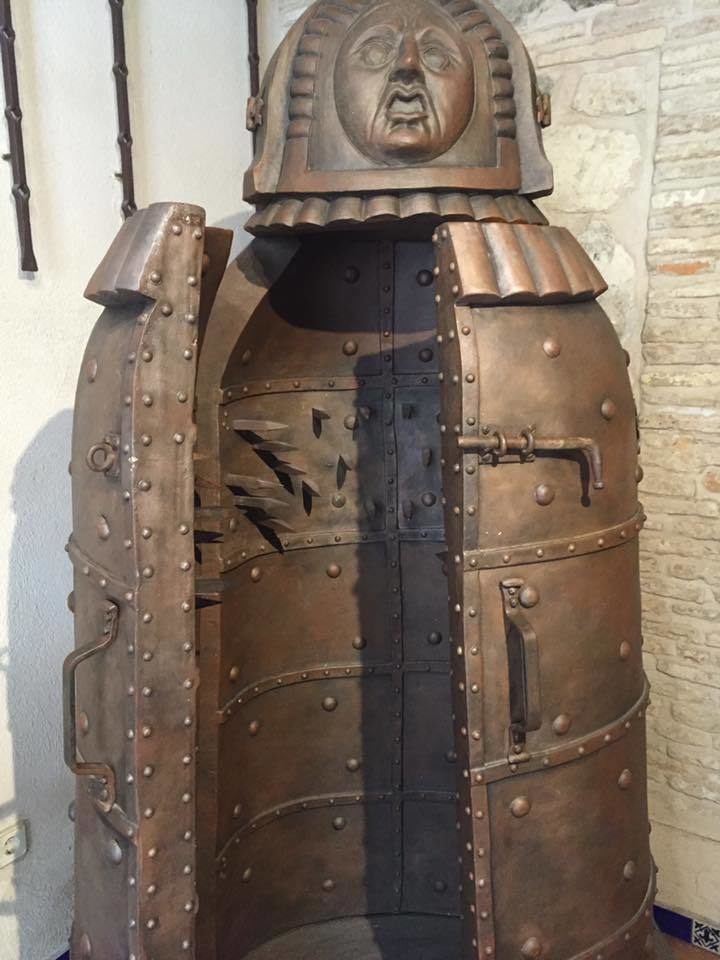
Interrogation Chair 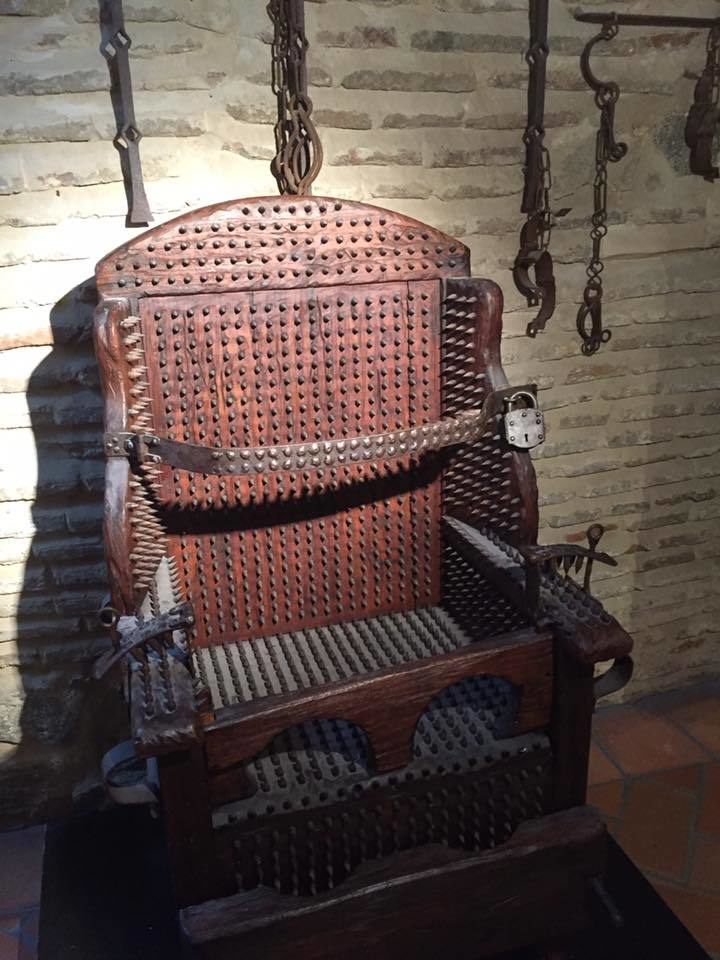
Tools like the thumb vice were often used to force a confession or repentance, inflicting pain without risking death on the victim. The interrogation seat was lined with spikes that could be heated before a prisoner was locked into place. Some pieces like the Garrote Vil were used long after the Inquisition had ended. The neck-crushing collar was used in Spain as recently as the 1970s.
Judas seat 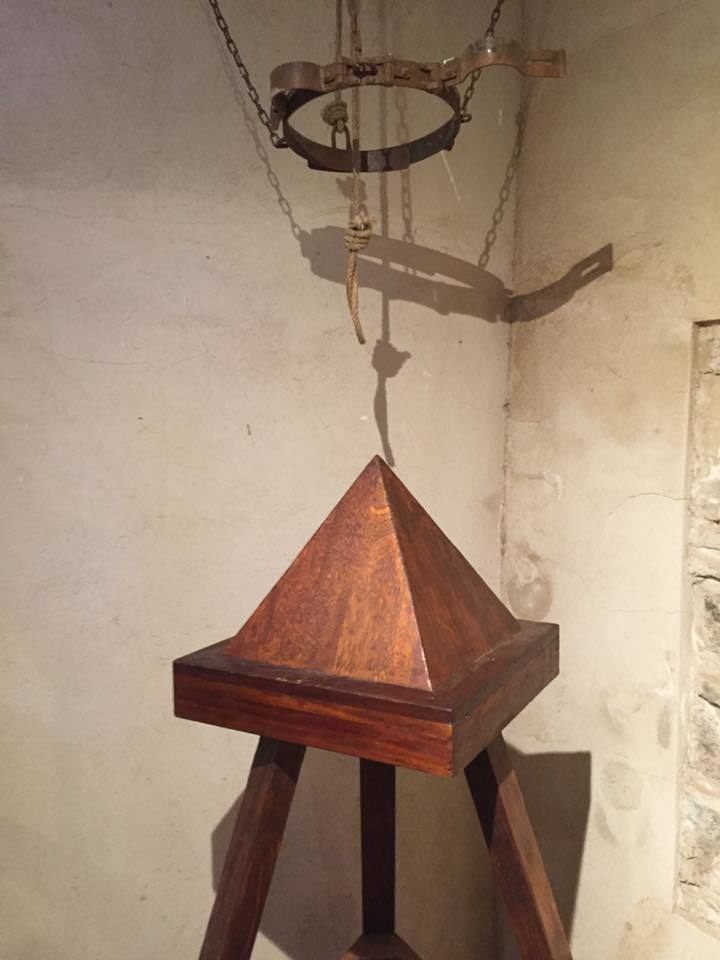
Shame mask 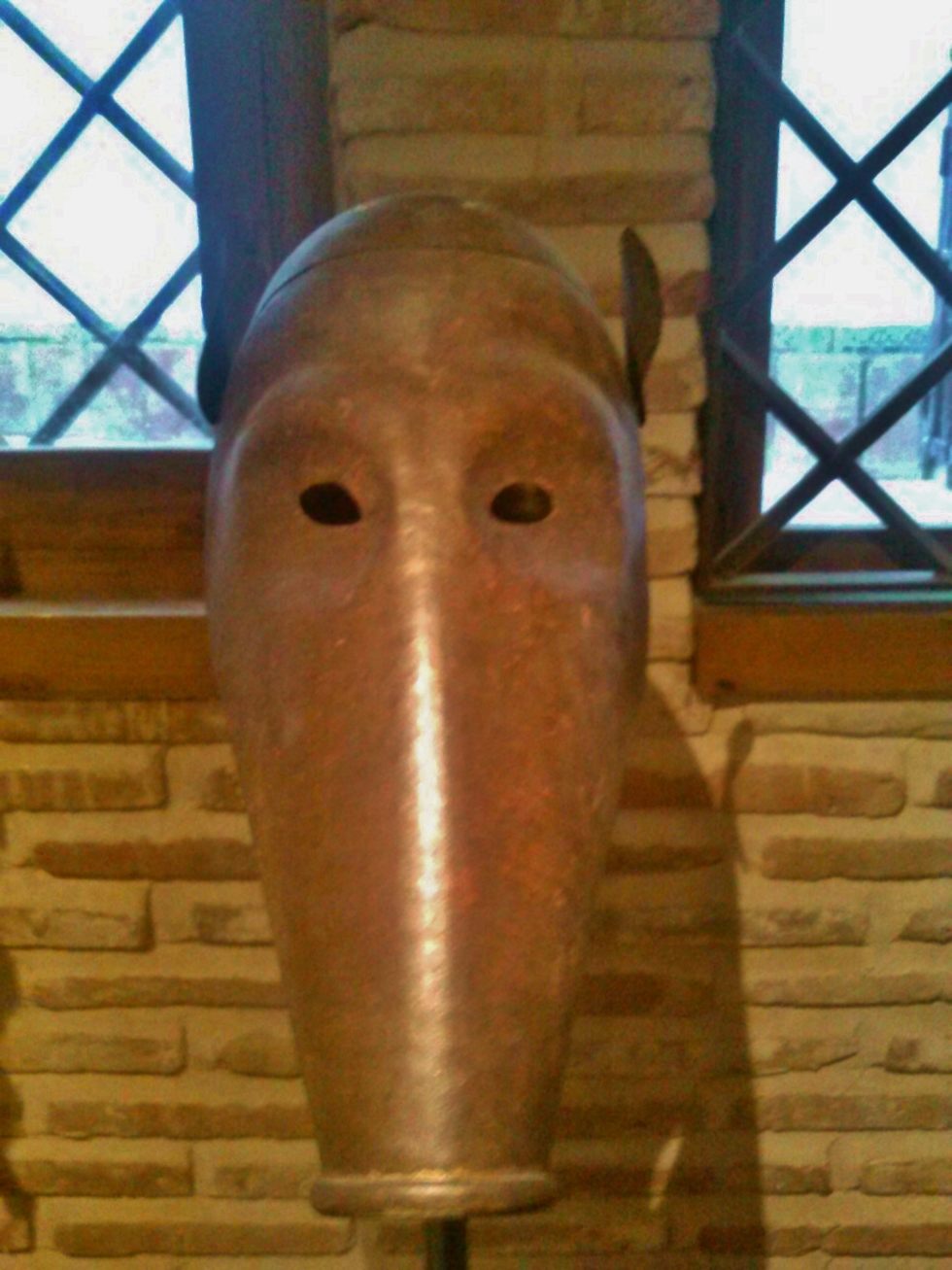
The side room features contraptions designed for public ridicule, including a heavy wooden barrel held on the shoulders of those accused of drunkenness. The iron shame masks were intended to humiliate the wearer, but also provided a burdensome strain on the prisoner’s body. The museum also displays executor’s hooded garb and axe as well as the tattered Sambenito, a garment worn by prisoners during their public auto-da-fé.
The museum presents its artefacts without sensationalising torture and provides a stark look at the social conditions of Inquisition-era Spain.
 1
Like
Published at 7:30 PM Comments (1)
1
Like
Published at 7:30 PM Comments (1)
The Capirote at Easter
Friday, April 11, 2025
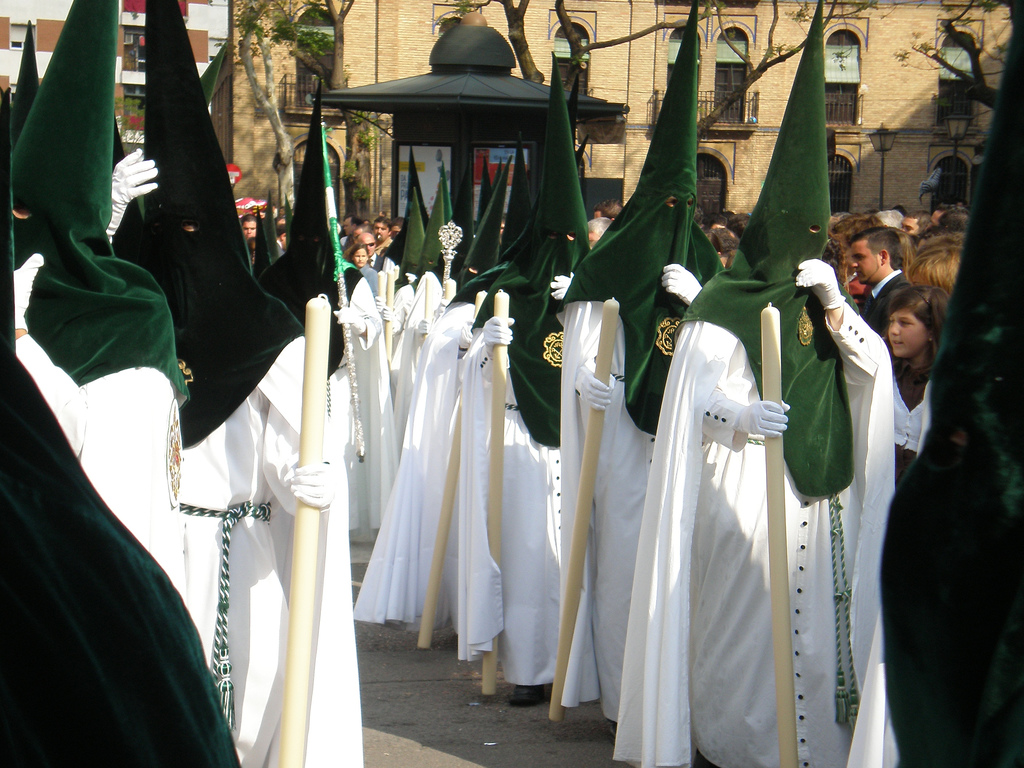
A capirote is a pointed conical hat that is used in Spain. It is part of the uniform of some brotherhoods including the Nazarenos and Fariseos during Easter processions and reenactments in some areas during the Holy Week in Spain.
Historically the flaggelants are the origin of these current traditions, as they flogged themselves to do penance. Pope Clemens VI ordered that flagellants only under control of the church could perform penance; For this he decreed "Inter sollicitudines". This is considered one of the reasons why flaggelants often hide their faces.
The use of the capirote or coroza was proscribed in Spain and Portugal by the Holy Office of the Inquisition. Men and women who were arrested had to wear a paper capirote in public as sign of public humiliation. The capirote was worn during the session of an 'Auto-da-fé'. The colour was different, conforming to the judgement of the office. People who were condemned to be executed wore a red coroza. Other punishments used different colours and drawings to show the punishment to be received.
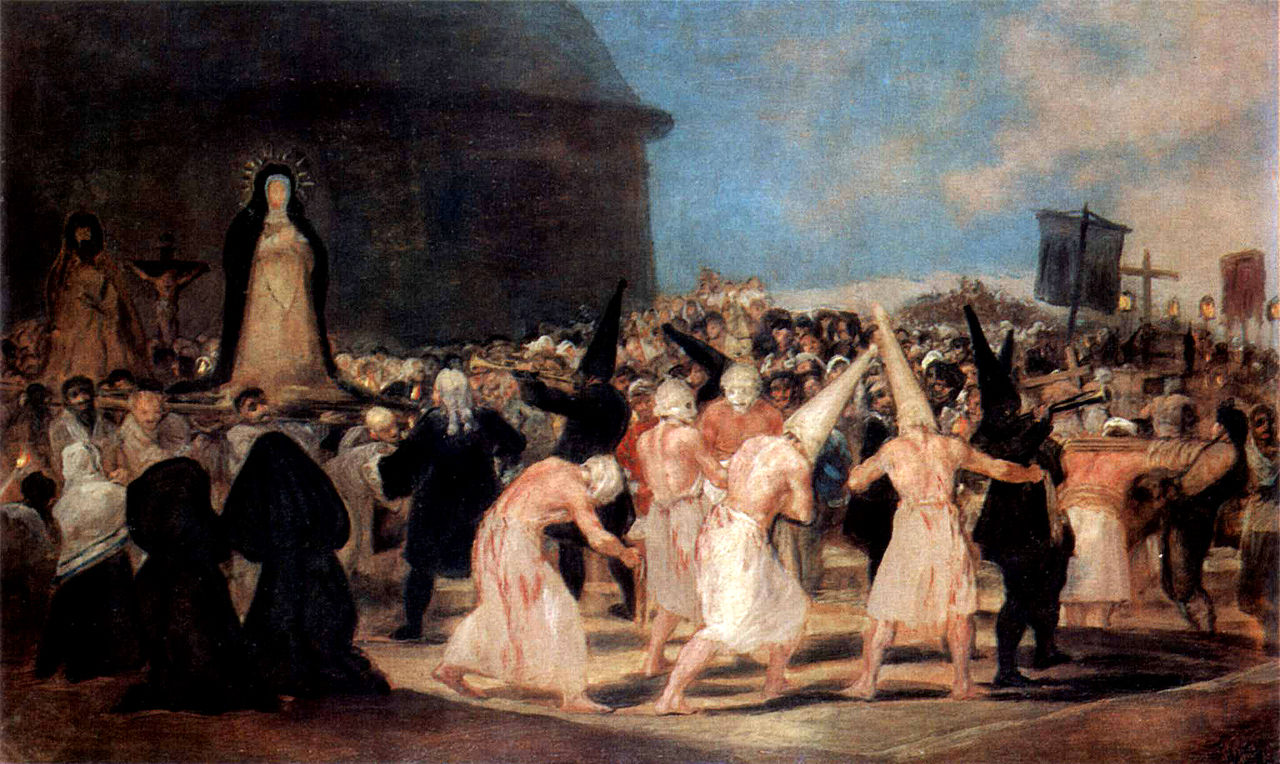
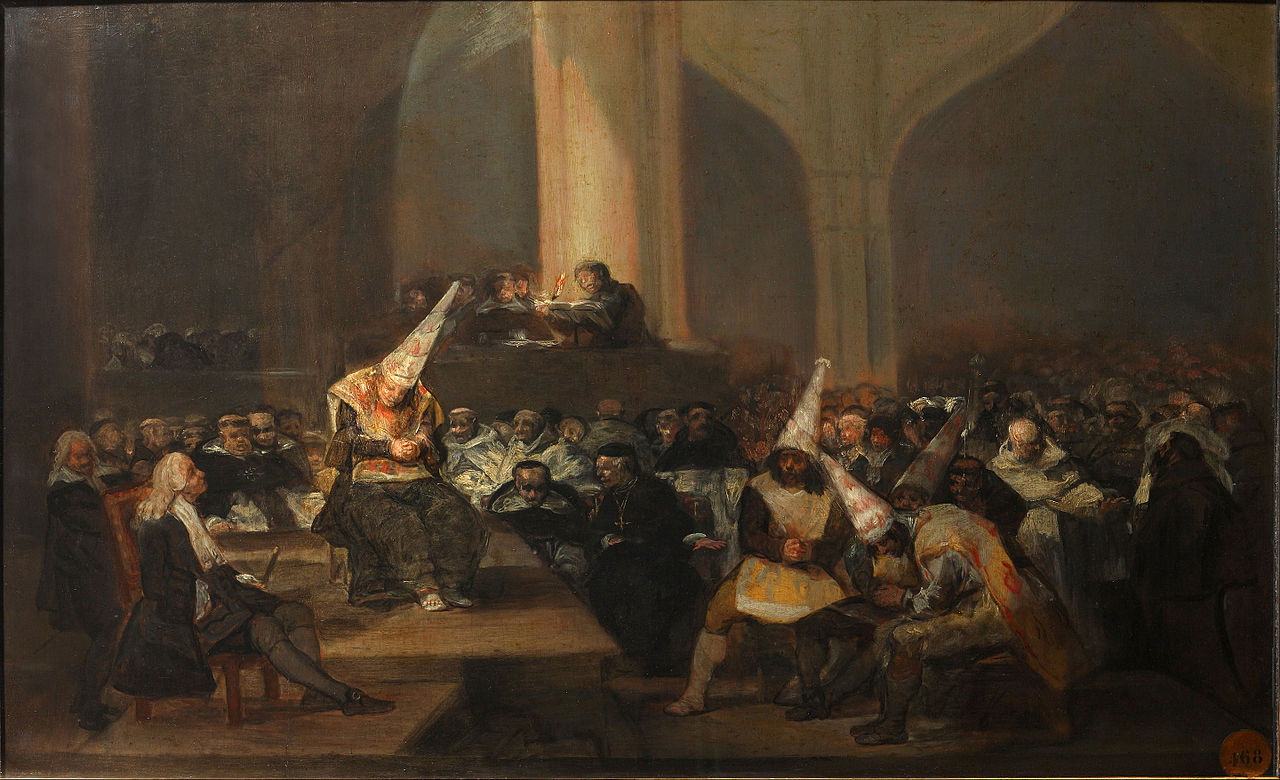
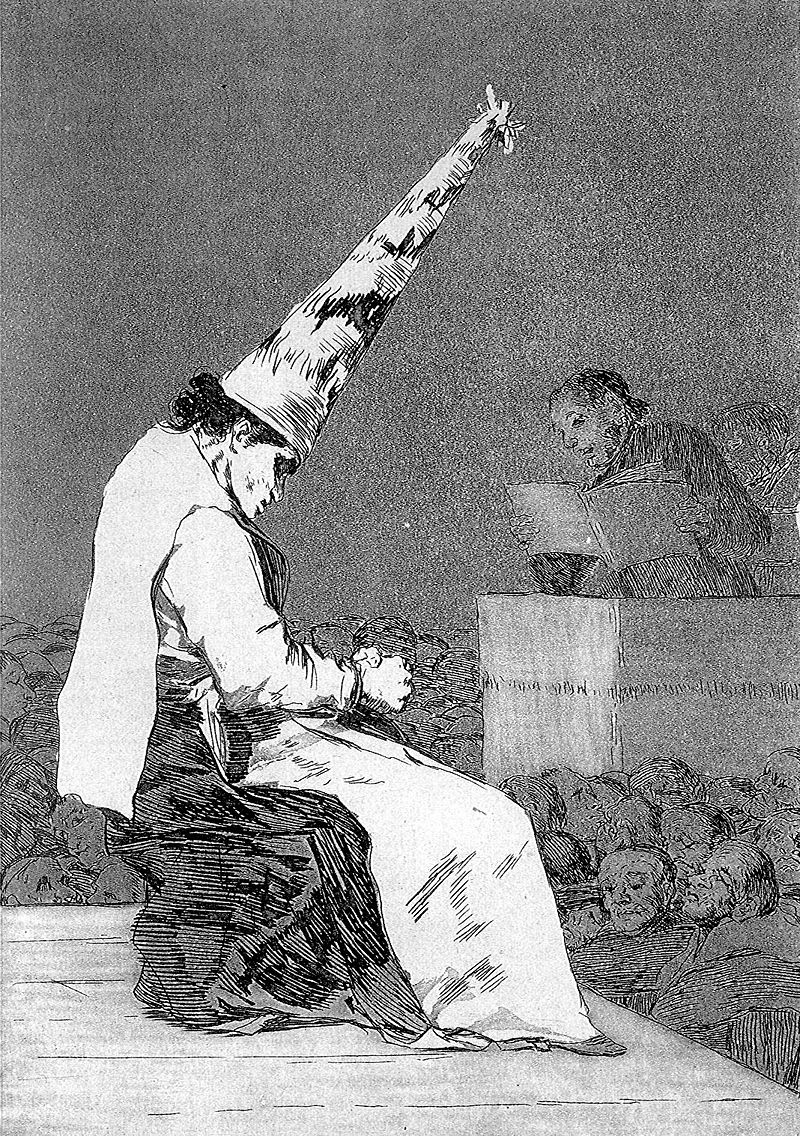 When the Inquisition was abolished, the symbol of punishment and penitence was kept in the Catholic brotherhood. However, the capirote used today is different: it is covered in fine fabric, as determined by the brotherhood. Later, during the celebration of the Holy Week/Easter in Andalusia, penitentes (people doing public penance for their sins) would walk through streets with the capirote. The capirote is today the symbol of the Catholic penant: only members of a confraternity of penance are allowed to wear them during solemn processions. Children can receive the capirote after their first holy communion, when they enter the brotherhood. When the Inquisition was abolished, the symbol of punishment and penitence was kept in the Catholic brotherhood. However, the capirote used today is different: it is covered in fine fabric, as determined by the brotherhood. Later, during the celebration of the Holy Week/Easter in Andalusia, penitentes (people doing public penance for their sins) would walk through streets with the capirote. The capirote is today the symbol of the Catholic penant: only members of a confraternity of penance are allowed to wear them during solemn processions. Children can receive the capirote after their first holy communion, when they enter the brotherhood.
Historically the structure is called the capirote, but the brotherhoods cover it with fabric together with their face, and the medal of the brotherhood that is worn underneath. The cloth has two holes for the penant to see through. The insignia or crest of the brotherhood is usually embroidered on the capirote in fine gold.The capirote is worn during the whole penance. In Sevilla, it is not allowed to enter the cathedral without the capirote.
In New Orleans during the period between the Rebellion of 1768 and the abolishment of the Spanish cabildo, the more risqué Mardi Gras celebrations of the traditionally French Catholic residents were strictly curtailed by incoming Spanish clergy. The anti-Catholic 'second' Ku Klux Klan that arose at the beginning of the twentieth century may have modeled part of their regalia and insignia on the capirote and sanbenito as a sardonic nod to the enforcement of these restrictions on masquerades a century earlier.
 0
Like
Published at 2:29 PM Comments (0)
0
Like
Published at 2:29 PM Comments (0)
Barcelona's Timeless Absinthe Haven
Friday, March 21, 2025
Deep in the heart of Barcelona's El Raval district lies a veritable time capsule, a watering hole that has witnessed nearly two centuries of history unfold within its walls. Bar Marsella, founded in 1820, stands proudly as the oldest bar in the Catalan capital, offering patrons a glimpse into a bygone era whilst serving up its infamous house speciality: absinthe.
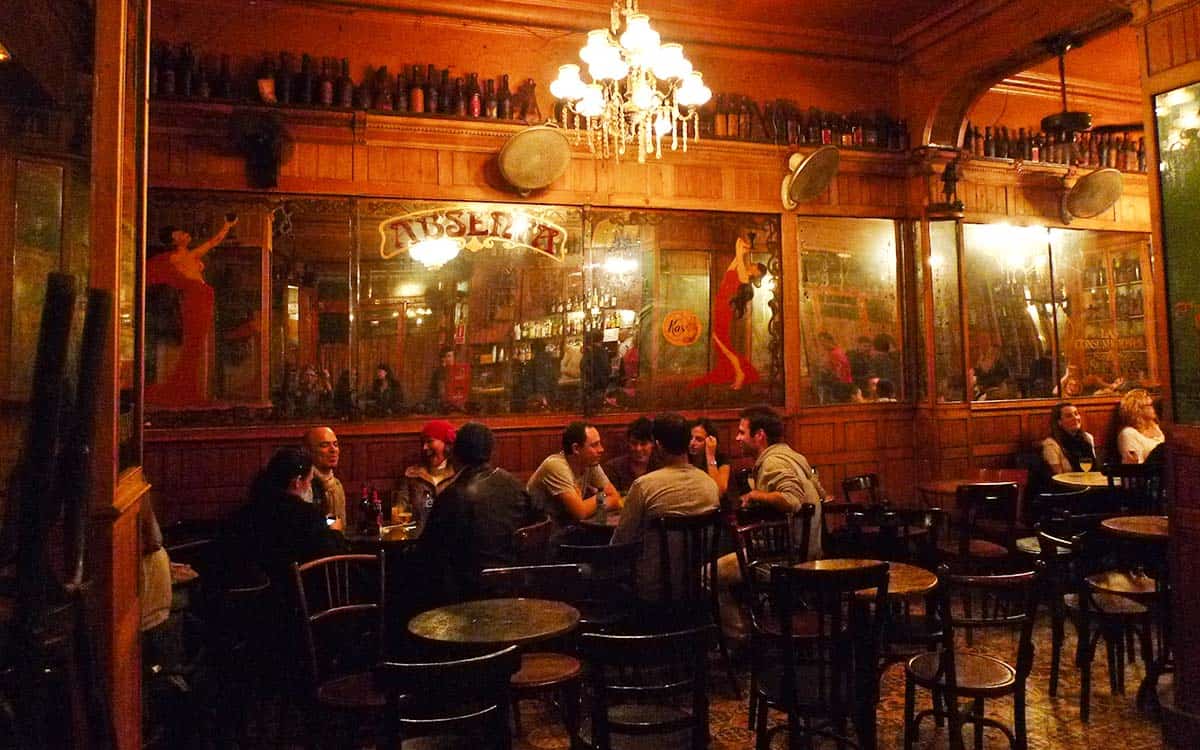
As you step through the doors of Bar Marsella, you're immediately transported to another age. The décor, virtually untouched since its opening, speaks volumes of the bar's rich history. Chipped paint adorns the ceiling, cloudy mirrors line the walls, and a handful of ceiling fans struggle valiantly against the Mediterranean heat. The overall effect is one of charming dilapidation, a far cry from the polished establishments that populate much of modern Barcelona.
Behind glass shelves, rows of dusty wine bottles stand sentinel, many belonging to regular patrons who purchase their favourite tipple to enjoy on subsequent visits. Black-and-white photographs of the owner's family mingle with other curios, including a statue of Saint Martin, patron saint of drinkers—a fitting guardian for this temple of libations.
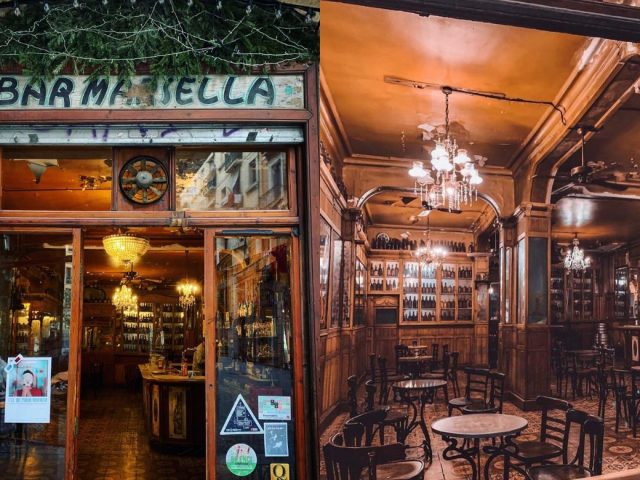
In its early days, Bar Marsella was situated in what was then a notorious neighbourhood. El Raval in the 19th century was a hotbed of organised crime, prostitution, and gambling. The bar's survival through these tumultuous times is a testament to its resilience and enduring appeal.
As the years passed, Bar Marsella became a magnet for artists, intellectuals, and bohemians. Its reputation grew, attracting some of the most celebrated figures of the 20th century. While it's unlikely they all visited simultaneously, the bar proudly claims Pablo Picasso, Ernest Hemingway, and Salvador Dalí among its illustrious former patrons.
During the oppressive regime of Francisco Franco, Bar Marsella is said to have played host to clandestine meetings of dissidents and free-thinkers. A curious relic from this period remains: a sign prohibiting singing, a reminder of the strict controls once placed on public gatherings and expressions of freedom.
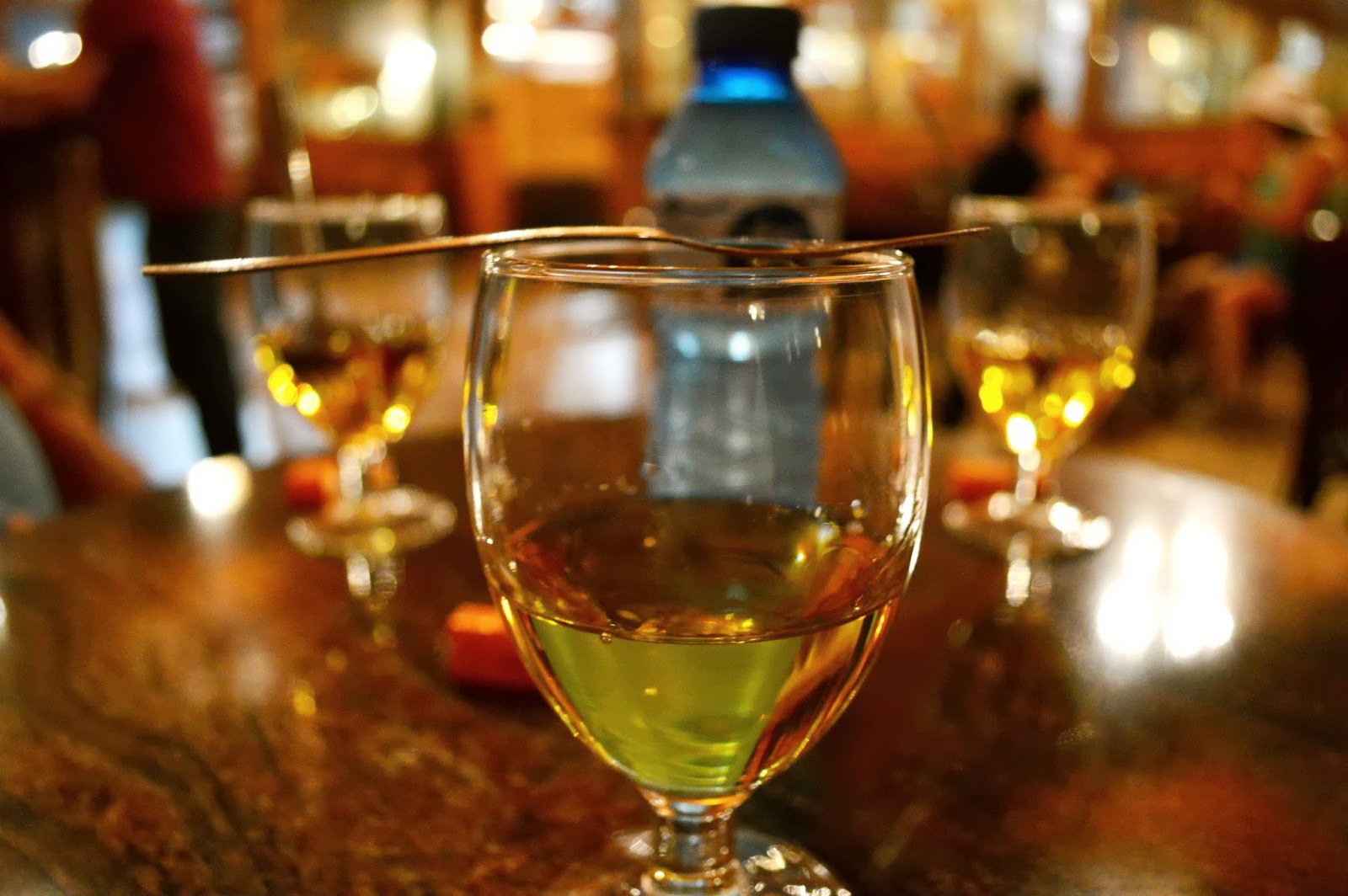
The Green Fairy's Lair
While Bar Marsella offers a variety of libations, it's best known for its absinthe. This potent, anise-flavoured spirit, often referred to as 'The Green Fairy', has long been associated with creativity, hallucinations, and the Parisian bohemian set of the late 19th and early 20th centuries.
Bar Marsella's homemade absinthe is served in the traditional manner: a sugar cube is placed on a slotted spoon atop a glass of the emerald liquor. Ice-cold water is then slowly dripped over the sugar, dissolving it into the absinthe below. As the water mingles with the spirit, it creates a cloudy, opalescent effect known as the 'louche'.
This ritual, performed countless times over the decades, connects modern-day visitors with the artists, writers, and revolutionaries who once sought inspiration—or perhaps oblivion—in the same drink, in the same location.
In 2013, Bar Marsella faced an existential threat. The building housing this historic establishment was slated for closure, potentially ending nearly two centuries of continuous operation. However, the bar's significance to the local community and its place in Barcelona's cultural landscape sparked a grassroots movement to save it.
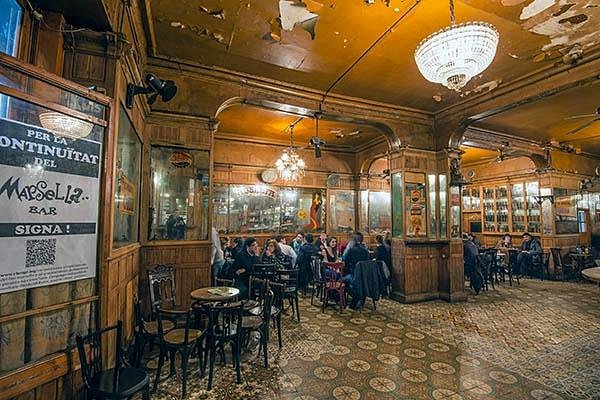
Regulars, neighbours, and supporters from across the city rallied to protect what they saw as an irreplaceable piece of Barcelona's heritage. Their efforts paid off when the city council, recognising Bar Marsella's importance, stepped in to purchase the entire building. This intervention ensured that the bar could continue serving patrons for years to come, cementing its status as a local icon.
Today, Bar Marsella stands as a living museum, offering visitors a unique opportunity to step back in time whilst enjoying a drink. Its continued popularity is a testament to the enduring appeal of authenticity in an age of constant renewal and gentrification.
The bar's survival and thriving business model demonstrate that there's still a strong appetite for establishments that wear their history proudly. In a city known for its cutting-edge architecture and forward-thinking design, Bar Marsella provides a necessary counterpoint—a place where the past is not just remembered, but lived.
Visiting Bar Marsella
For those wishing to experience this slice of Barcelona's history firsthand, Bar Marsella is conveniently located between the Rambla del Raval and the famous Las Ramblas. The nearest metro station is Liceu.
The bar's opening hours reflect its nocturnal nature:
Tuesday to Thursday: 5 pm to 12 am
Friday and Saturday: 5 pm to 1:30 am
Sunday: 5 pm to 12 am
Closed on Mondays
Visitors should be prepared for a no-frills experience. The charm of Bar Marsella lies in its authenticity and history, not in modern comforts or elaborate cocktail menus. The absinthe, of course, is a must-try for those who've never sampled the infamous green spirit.
In a world of rapid change and constant modernisation, establishments like Bar Marsella become increasingly precious. It serves not only drinks but also as a portal to the past, allowing each visitor to feel a connection to the generations that came before.
Whether you're a history buff, an absinthe aficionado, or simply someone looking for a unique night out in Barcelona, Bar Marsella offers an experience unlike any other. Its survival against the odds—from neighbourhood transformations to political upheavals and near-closure—makes every visit feel like a small victory for preservation and tradition.
As you sip your drink in Bar Marsella, surrounded by the ghosts of artists, revolutionaries, and countless anonymous revellers, you become part of its ongoing story. In doing so, you help ensure that this remarkable piece of Barcelona's heritage continues to thrive, ready to welcome curious visitors for many years to come.
 1
Like
Published at 11:58 PM Comments (0)
1
Like
Published at 11:58 PM Comments (0)
Naming Seas: A National Prerogative?
Monday, February 24, 2025
Have you ever considered how much power lies in a name? The recent renaming of the Gulf of Mexico to the Gulf of America by the United States has ignited a debate about just that – the power of names to shape our understanding of the world, assert national identity, and even influence international relations. Let's delve into the heart of this debate, comparing the American renaming of the Gulf of Mexico to the situation in Europe, where the Bay of Biscay is known by different names in different countries. By exploring these two cases, we can uncover the complexities surrounding the naming of shared geographical features and the delicate balance between national sovereignty and international cooperation.
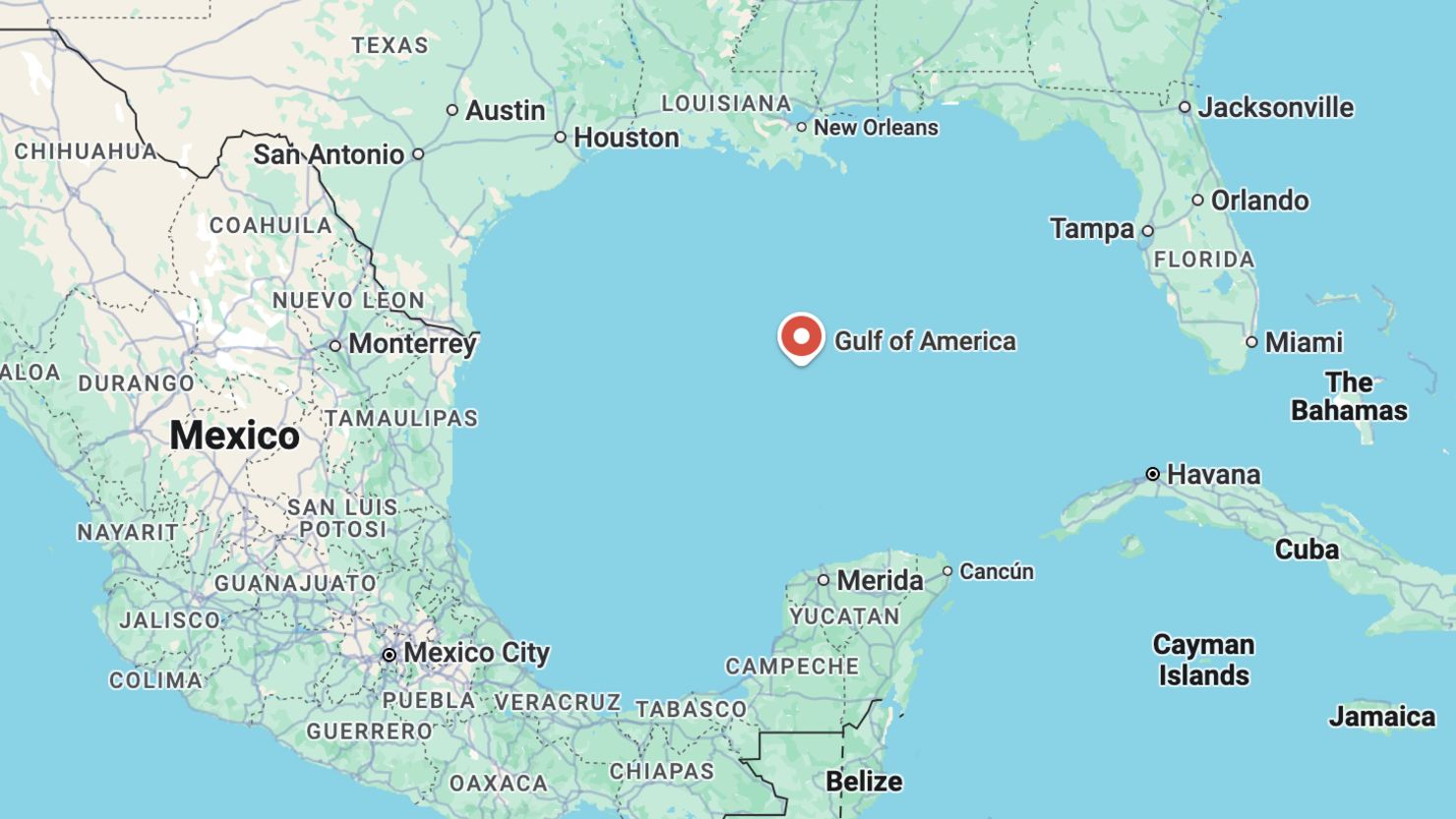
The Gulf of Mexico
The Gulf of Mexico, the ninth-largest body of water in the world, holds a captivating history. Its shores, stretching 2,700 km along the southern coast of the United States, have witnessed the ebb and flow of civilisations, from the ancient Mayans, who likely called it "nahá" (great water), to the Aztecs, who referred to it as "Chalchiuhtlicueyecatl" (House of Chalchiuhtlicue, their deity of the seas). Spanish explorers, arriving in the 16th century, sought to claim this "gem" for Europe, initially dubbing it "Golfo de Nueva España" (Gulf of New Spain). Over time, it became colloquially known as the "Spanish sea" due to its use as a maritime route to Spain.
Despite this long and layered history, in 2025, President Donald Trump issued an executive order to rename the Gulf of Mexico the "Gulf of America". This move, officially enacted by the U.S. Board on Geographic Names, aimed to "restore names that honour American greatness". The impact was immediate, with Google Maps and Apple Maps swiftly updating their platforms to reflect the change for American users.
However, this seemingly simple act of renaming has stirred a tempest in a teapot. Mexico and Cuba, who share the Gulf with the United States, have rejected the new name. Furthermore, the United Nations Convention on the Law of the Sea stipulates that a nation's authority over naming extends only to its territorial waters, which reach just 12 nautical miles from its coast. Beyond that, the waters are considered international, raising questions about the legitimacy and broader acceptance of the "Gulf of America." As some commentators have pointed out, this renaming may ultimately have limited practical implications, unlikely to be adopted by the international community or significantly alter how the Gulf is perceived globally.
Beyond the political implications, the Gulf of Mexico plays a crucial role in the ecological and economic landscape of the region. It is the origin point of the Gulf Stream, a powerful Atlantic current that influences the climate of the southeastern United States and even reaches the shores of Europe. However, the Gulf also faces environmental challenges, including a vast "dead zone" – an area of low oxygen that threatens marine life. Despite these challenges, the Gulf remains a vibrant ecosystem, teeming with diverse marine life, including over 40 species of sharks.
The renaming of the Gulf of Mexico raises fundamental questions about the relationship between a place and its name. Is it merely a label, or does it carry a deeper meaning, reflecting history, culture, and even national identity? To explore this further, let's turn our attention across the Atlantic to another gulf with a multifaceted identity – the Bay of Biscay.
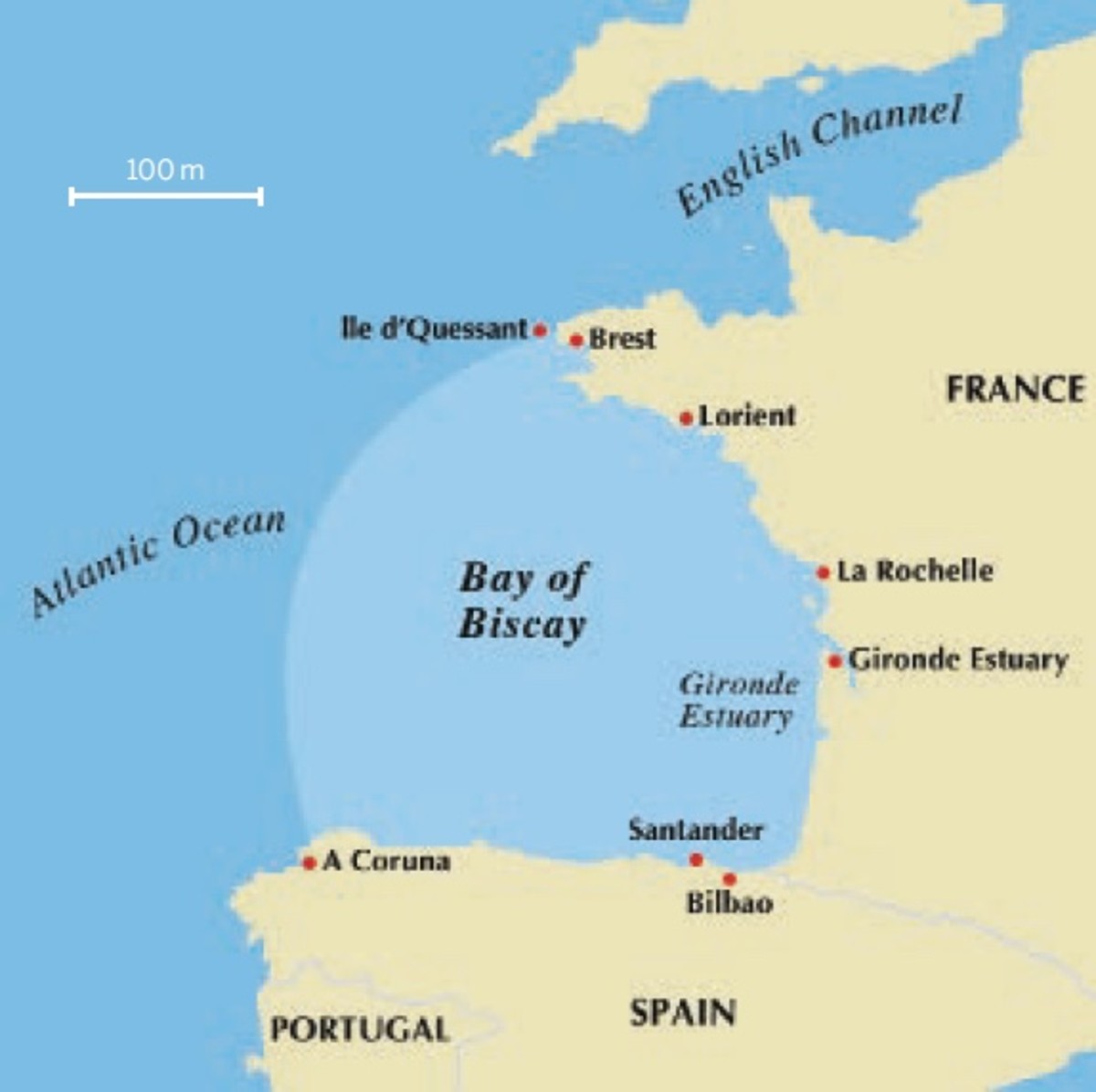
The Bay of Biscay
In contrast to the politically charged renaming of the Gulf of Mexico, the Bay of Biscay, nestled on the Atlantic coast of southwestern Europe, presents a different narrative – a story of organically evolved names reflecting the region's rich cultural heritage.
In France, it is known as the Golfe de Gascogne, a name derived from the Gascons, a people with a distinct language and culture who have long inhabited southwestern France. In Spain, it is called the Golfo de Vizcaya, after the Basque province of Biscay, a historical centre of Basque culture. Adding another layer to this linguistic tapestry, the southern part of the bay, bordering the northern coast of Spain, is also known as the Cantabrian Sea.
This multiplicity of names is not a source of conflict but rather a testament to the historical interplay of cultures in this region. The Bay of Biscay has long been a crossroads of maritime activity, shaped by the seafaring traditions of the Basques, who were renowned whalers and navigators. The bay's English name, in fact, is thought to originate from the Basque districts of Biscay.
The Bay of Biscay is also known for its challenging sailing conditions, particularly during the winter months, when fierce storms and high waves have led to numerous shipwrecks throughout history. This has earned it the nickname "The Valley of Death" among sailors. Despite these dangers, the bay has been a vital maritime route, witnessing historical events like the Battle of the Bay of Biscay during World War II.
Beyond its human history, the Bay of Biscay is a unique ecological zone, a transition area between subtropical and boreal regimes, supporting a rich diversity of marine life.
The Bay of Biscay stands as a counterpoint to the Gulf of Mexico, illustrating how names can evolve organically, reflecting the cultural and historical nuances of a region. This raises the question: why do some places have multiple names while others become the subject of naming disputes? To delve deeper into this, let's explore the history and politics of naming waters.
The History and Politics of Naming Waters
The naming of bodies of water has a long and fascinating history, often intertwined with exploration, trade, and the assertion of power. Early civilisations named seas and oceans based on their location, characteristics, or mythological figures. For example, the Atlantic Ocean was named after the Titan Atlas from Greek mythology.
Over time, as maritime travel and trade expanded, the need for standardised names became apparent. International organisations like the International Hydrographic Organization (IHO) emerged to promote uniformity in nautical charts and publications. The IHO's publication "Limits of Oceans and Seas" (S-23) defines the boundaries and names of major water bodies, aiming to ensure consistency across different languages and cultures.
However, despite these efforts, naming disputes persist. One prominent example is the Sea of Japan naming dispute, where South Korea advocates for the name "East Sea". This dispute highlights the challenges of reconciling historical claims, national identities, and international standards. Historical maps and documents are often used to support different positions, making it difficult to reach a consensus.
The act of naming, particularly in the context of shared geographical features, can be seen as an exercise of power. By imposing a name, a nation or group can assert dominance, control, or a particular narrative about a place. This is evident in the Gulf of Mexico case, where the renaming can be interpreted as an attempt to emphasise American influence in the region.
The Sea of Cantabria: Echoes of the Past
Within the Bay of Biscay lies the Cantabrian Sea, a region with a unique history and identity. Its name harkens back to the ancient Cantabri, a Celtic tribe known for their fierce resistance to Roman rule. This historical connection adds another dimension to the discussion of naming conventions, highlighting the importance of recognising the deep roots of a place and its people.
The Cantabrian Sea boasts a dramatic coastline characterised by steep cliffs, sandy beaches, and numerous estuaries and inlets. This diverse geography supports a rich marine ecosystem, and the Cantabrian Sea has long been an important fishing ground, contributing to the economic development of the region.
Beyond its natural beauty, Cantabria is a treasure trove of archaeological sites, including the world-famous Altamira cave paintings, a testament to the region's ancient human history. The Cantabrian Sea's complex geomorphology, with its submarine canyons and seamounts, further adds to its unique character.
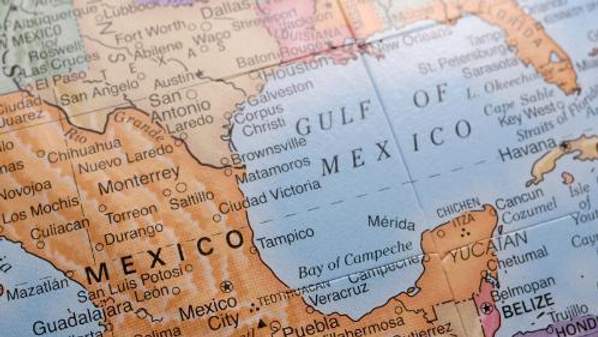
Naming Conventions and National Identity: A Delicate Balance
The contrasting cases of the Gulf of Mexico and the Bay of Biscay illuminate the intricate relationship between naming conventions and national identity. While the United States' renaming of the Gulf of Mexico can be seen as an attempt to assert national sovereignty and project an image of American exceptionalism, the diverse names for the Bay of Biscay reflect a more nuanced approach, acknowledging the historical and cultural contributions of different groups to the region's identity.
The naming of geographical features is not simply a matter of cartographic accuracy; it is a reflection of how we perceive and interact with the world around us. Names carry historical and cultural weight, shaping our understanding of place and belonging. In the case of shared geographical features, the choice of names can become a point of contention or a symbol of cooperation.
The unilateral decision to rename the Gulf of Mexico has met with resistance from neighbouring countries, highlighting the potential for conflict when national interests are prioritised over international consensus. In contrast, the different names for the Bay of Biscay demonstrate a more inclusive approach, recognising the diverse cultural heritage of the region.
It is worth noting that the practice of naming places after rivers is not limited to bodies of water. Countries like Lithuania (named after the Lietava River) and cities like Amsterdam (named after the Amstel River) demonstrate how this convention extends to broader geographical features. Even the River Styles Framework, a system for classifying and naming river types, uses a hierarchical approach that incorporates geographical and geomorphological factors.
The renaming of the Gulf of Mexico and the diverse names for the Bay of Biscay offers valuable lessons about the complexities of naming conventions, national sovereignty, and the power of names to shape our understanding of the world. While each country has the right to name geographical features within its own territory, the naming of shared international waters requires a more delicate approach, one that considers the historical context, cultural diversity, and interests of all involved parties.
The examples demonstrate that naming is not merely a technical exercise but a reflection of national identity, cultural values, and even geopolitical tensions. By understanding the historical and geographical context of these naming conventions, we can gain a deeper appreciation for the challenges of international relations and the importance of fostering cross-cultural understanding in a world where geographical features often transcend political boundaries. Ultimately, the names we use for the places we share can either divide us or bring us together.
 3
Like
Published at 12:50 PM Comments (2)
3
Like
Published at 12:50 PM Comments (2)
Discover the Coldest Town in Spain: Molina de Aragón
Saturday, February 15, 2025
When one imagines Spain, the mind typically drifts to images of sun-drenched beaches, bustling cities, and the warm Mediterranean climate. However, Spain is a country of diverse climate zones, some of which might come as a surprise to those more familiar with its sunny side. One such place is Molina de Aragón, renowned for being the coldest town in the entire country.

Spain's Chilling Gem: Molina de Aragón
Nestled in the province of Guadalajara, Molina de Aragón stands at an impressive altitude of 1,060 metres. This elevation, combined with its geographical positioning, contributes to its reputation as Spain’s coldest town. Often, it is mentioned alongside Teruel and Calamocha as part of the “cold triangle,” a region known for its particularly cold climate.
In January 1952, Molina de Aragón experienced a bone-chilling record temperature of -28.2ºC. Despite the historical coldest temperature in Spain being recorded in Calamocha at -30ºC in 1963, Molina de Aragón continues to experience consistently freezing winters, with an average winter minimum of -3.5ºC. Even in the summer, the town recorded a minimum temperature of just 0.6ºC in June 2019, further emphasising its exceptionally cold climate.
Beyond its cold climate, Molina de Aragón boasts a rich historical and cultural heritage, making it an attractive destination for tourists and potential residents alike. Here are some of the must-see attractions in this unique town:
Molina de Aragón Castle: This medieval fortress, the largest in Guadalajara, offers panoramic views of the town and the surrounding landscape. Its historical significance and imposing presence make it a highlight for visitors.
Roman Bridge: Crossing the Gallo River, this picturesque bridge provides a beautiful spot for a leisurely stroll while soaking in the serene natural beauty of the area.
Plaza de España: This bustling plaza is the heart of Molina de Aragón. Surrounded by traditional architecture, it's the perfect place to immerse yourself in local life and enjoy the town’s charming atmosphere.
Molina Museum: A visit to this museum offers a journey through the history and culture of the region, with exhibitions spanning from prehistoric times to the modern day.
Alto Tajo Natural Park: Located just a few kilometres from Molina de Aragón, this natural park is a haven for outdoor enthusiasts, featuring an array of hiking trails and abundant biodiversity.
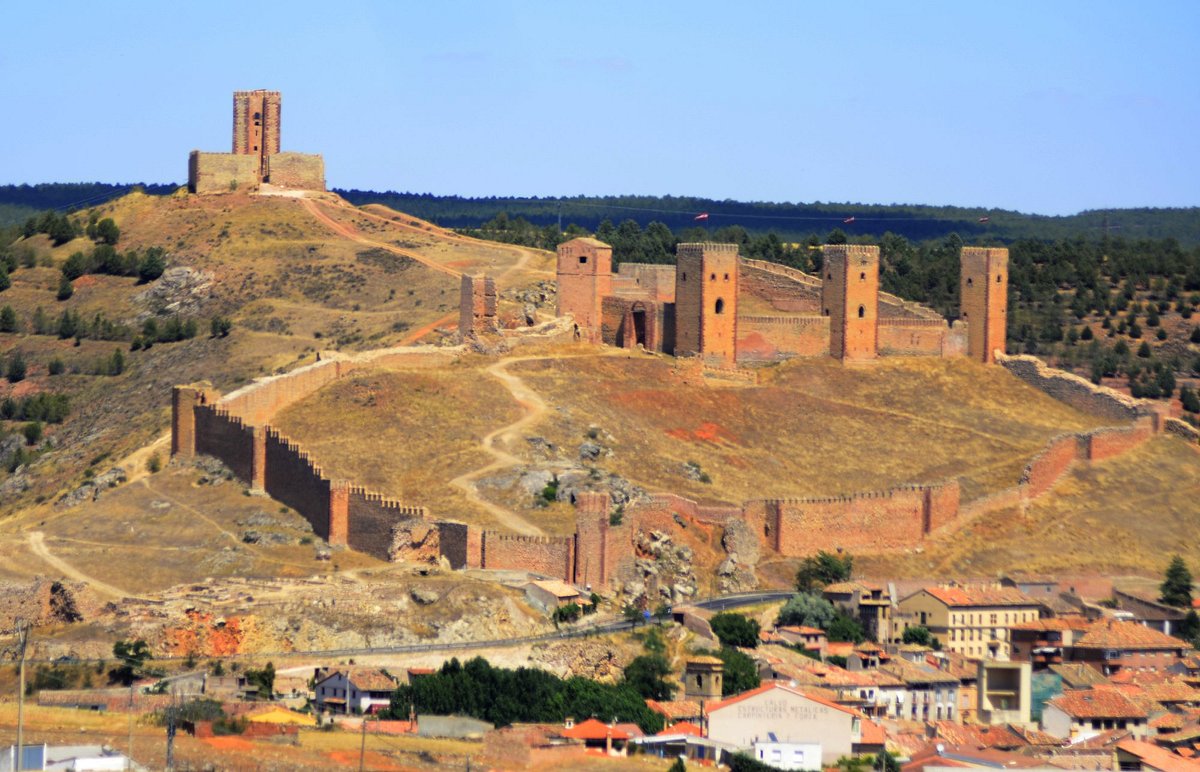
A Unique Lifestyle in Molina de Aragón
Living in Molina de Aragón is an experience that seamlessly blends tranquillity with a close connection to nature. Despite its chilly winters, the town offers an outstanding quality of life characterised by a welcoming community and peaceful surroundings.
The town’s residents enjoy a relaxed pace of life, surrounded by breathtaking mountainous landscapes. The crisp, fresh air encourages a simpler and slower lifestyle, one where the marvels of nature can be appreciated to the fullest extent.
Escape the Heat: Spain's Coolest Summer Retreats
While Molina de Aragón is renowned for its cold winters, it might surprise some to learn that it also offers respite from the intense summer heat that characterises much of Spain. The region’s mild summer climate can be a welcome relief, especially considering the 0.6ºC temperature recorded in June 2019.
Other places in Spain also offer a cooler summer experience. The Picos de Europa National Park, for instance, stands out as one of the most refreshing spots during the hottest months. Similarly, the town of Capileira, located in the foothills of the Sierra Nevada in Granada, is also known for its cool summer climate.
To truly appreciate Molina de Aragón’s chilly climate, one might consider the coldest inhabited place on Earth: Oymyakon in the Sakha Republic (Yakutia), Russia. Known as the Pole of Cold, this remote village endures severe winters with temperatures plunging to as low as -50ºC.
The village’s location in a valley, surrounded by mountains, traps cold air, resulting in these extreme conditions. Life in Oymyakon is uniquely challenging, with residents adapting to a world where ink in pens can freeze, cars must be kept running to remain operational, and metal glasses are too dangerous to wear due to the risk of sticking to the skin. Even saliva can freeze before hitting the ground.
Molina de Aragón, with its historically low temperatures and picturesque landscapes, offers a distinctive side of Spain. Its cold climate contrasts sharply with the usual perception of the country's warm weather. Yet, it provides a rich cultural and historical experience that attracts tourists and prospective residents alike. Whether you're looking to escape the heat or delve into Spain's frosty side, Molina de Aragón presents an intriguing and unique destination that stands out in the Iberian Peninsula.
 1
Like
Published at 12:10 PM Comments (0)
1
Like
Published at 12:10 PM Comments (0)
Spam post or Abuse? Please let us know
|
|